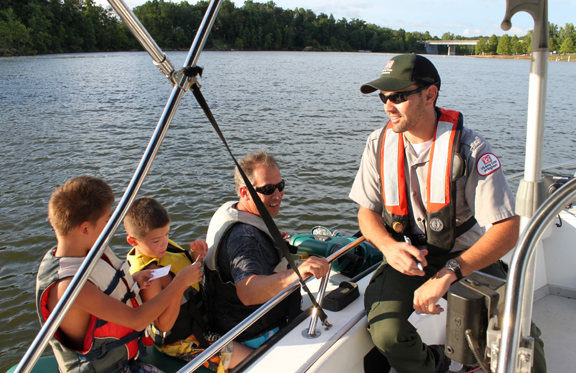
MEMORIAL DAY MESSAGE: The U.S. Army Corps of Engineers encourages boaters and swimmers to wear life jackets
(Louisville, Ky.) — Before you head out for a day on or near the water, the U.S. Army Corps of Engineers encourages you to make sure you have life jackets for everyone and that they please wear them. On average, 9 out of 10 people who drowned at a Corps of Engineers lake or river project didn’t wear a life jacket. Life jackets save lives by keeping you afloat and providing time for rescue.
Most people who drown never intended to be in the water; they unexpectedly fell from a boat or dock into the water. When this happens, a person will reflexively gasp and can inhale up to one liter of water and drown in less than a minute.
Others get into trouble swimming out to retrieve a boat that floated away, or swimming in association with a boat. Swimming in natural waters is not the same as swimming in a pool. Even strong swimmers can get into trouble and be gone within seconds. It takes an adult 60 seconds to drown and a child 20 seconds to drown. Swimming ability also decreases with age.
Swim at a designated swim beach. These areas have been inspected to provide a safe swimming environment. At all Corps of Engineers beaches you swim at your own risk so adults please watch your children, because most people drowned within 10 feet of safety. Many shorelines at Corps of Engineers lake and river projects have drop offs and you can be in water over your head instantly or pulled under by the current.
Here are some Water Safety Tips to consider:
According to the Corps, the majority of people (88%) who drown are male, 39% are 18-35 years old, 24% are 36-53 years old and 89% of the people who die in water-related accidents were not wearing a life jacket. Over 90% of the people who die in boating-related accidents had not taken a boating safety course.
TIP: Expect the Unexpected and Wear Your Life Jacket! You could be the next person to drown if you don’t play it safe. Your best defense against the unexpected is a life jacket. Wear your life jacket and encourage those you love to wear one too.
TIP: Learn to swim well and swim with a buddy. It only takes an average of 20 seconds for a child to drown and 60 seconds for an adult. Never let your children swim by themselves. Adult supervision is a must to ensure you don’t lose the ones you love. Swimming ability decreases with age so even if you are a strong swimmer wear your life jacket especially in open water conditions.
TIP: Many people who drown never intended to enter the water and they drown within 10-30 feet of safety. Sixty percent of the time people who drown were either witnessed by someone or there were people in the area that could have helped save them.
TIP: Learn to identify the four signs of a person who is drowning. The drowning signs are head back, mouth open, no sound and arms slapping the water in an up and down motion.
TIP: The proper ways to rescue someone in the water that is in distress is to reach, throw, row, don’t go. Reach something out to the person without endangering yourself, throw them something that floats, row your boat close to the person with the motor off. Never attempt an in-water rescue unless you are trained to do so. Instead, go for help or send someone else for help. Oftentimes a double-drowning occurs when someone enters the water to attempt a rescue because a person fighting for their life is extremely strong and in order to stay afloat they will hold the person who is trying to help them underwater.
TIP: Take a boater safety course and boat with a buddy. According to the U.S. Coast Guard 88% of the people that died in a boating accident were on vessels where the operator had not taken a NASBLA-approved boater safety course. There are on-line courses available at www.boat-ed.com. US Coast Guard Auxiliary http://cgaux.org/boatinged and US Power Squadrons www.usps.org offer courses in most states. As a bonus, many insurance companies offer reduced rates for taking a boating safety course.